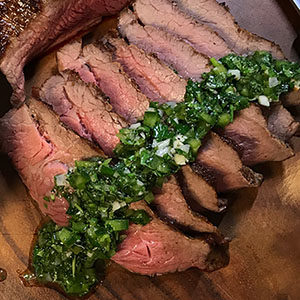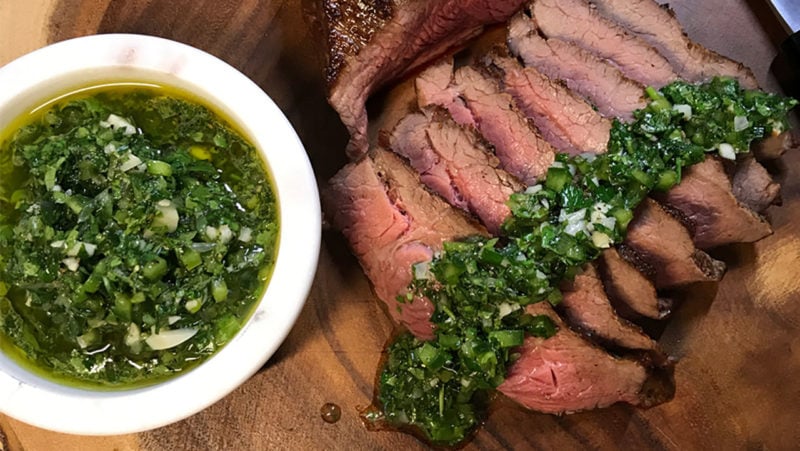Last Updated on January 28, 2025
Whether as a marinade or a sauce, it’s tough to deny that one of the best complements to a good steak is some freshly made chimichurri sauce.
Chimichurri sauce is easy to make, adds immense flavor, and has a long tradition of making meat taste better.
A favorite in Latin American cultures cuisines, chimichurri has exploded as one of South America’s greatest culinary exports.
What’s in Chimichurri Sauce?
Chimichurri is a meat accompaniment that derives from Argentina and Uruguay. Most commonly, it is made of minced garlic, chopped parsley, and dried oregano, mixed with either white vinegar, olive oil, or both. Sometimes, other ingredients can include kosher salt, freshly ground pepper, cilantro, and onions. In Uruguay, red pepper flakes or other hot peppers are often included in chimichurri.
Chimichurri is most often used as a post-cooking sauce for steaks, other beef dishes, or sausage. Some chefs or backyard cooks also use chimichurri as a marinade, although that is less popular than the condiment in sauce form.
The Unknown Origin of Chimichurri’s Name
While its origins in South America aren’t disputed, the name of the sauce is unclear; some of the etymology myth of chimichurri is quite unbelievable.
The most likely backstory for chimichurri is that it was invented by gauchos, Argentinian cowboys, who used dried herbs with the beef they cooked in the traditional way, over a wood-burning fire.
One theory about the name chimichurri is that it is a misunderstanding of the Basque language word “tximitxurri,” which sound like chimichurri when pronounced, and means “a mixture of several things in no particular order.”
The oddest explanation for the name is that it is a mispronunciation of “Jimmy curry,” or “Jimmy McCurry,” the supposed Irishman/Englishman Latin American-based meat seller who invented the sauce and may have fought for Argentine independence.
How to Make Chimichurri
No matter the history, our ButcherBox Head Chef Yankel Polak is a huge fan of the sauce. As he explained, he was first introduced to chimichurri when he was a teenager living in Jerusalem. “When we could cobble enough money together for a big night out at a steakhouse, there was an Argentinian place called El Gaucho that would serve giant slabs of meat on heated stones.”
“A South American friend pushed a bowl over to me and said try this, it’s the ketchup of Argentina,” Chef Yankel said. “I was confused until I tasted it and realized you could put that shit on anything.”
And, often, Chef Yankel does. We have many featured ButcherBox recipes with variations on chimichurri. “It’s like this perfect mouthwatering blend of salt and vinegar and super bright herbs,” Chef Yanked added. “It cuts through the richness of beef like a lightning bolt of flavor, which is crucial because after a few bites of steak your palate can dull.”
Here is one of Chef Yankel’s favorite spicy chimichurri recipes. As he explained, “Although the standard recipe is pretty straightforward, I’m into experimenting with it — trying different herbs, various acids, even mixing up the peppercorn elements.”
Chimichurri steak sauce can be used with the picanha cut — also known as coulotte, ribeye steak, or tri-tip as seen below.

Ingredients
- 1 pkg ButcherBox Tri-Tip Roast
- 1 Tbsp kosher salt
- 1 Tbsp avocado oil
Poblano-Lime Chimichurri
- ¼ c garlic minced
- 1 ea poblano pepper seeded and minced
- ½ c cilantro chopped
- ½ c parsley chopped
- 3 ea limes juiced
- ¼ c extra virgin olive oil
- 1 tsp kosher salt
- ½ tsp ground black pepper
Instructions
- Rub Tri-Tip all over with salt, then refrigerate uncovered on wire rack overnight.
Poblano-Lime Chimichurri
- Mix all ingredients together and refrigerate until ready to use. This can be made a day ahead to really let the flavors blend together.
Tri-Tip Roast
- On day of cooking, let tri-tip rest on the counter for 30-45 minutes until roast reaches room temperature, and season again with salt and pepper.
- Preheat oven to 425°F. Set aside wire rack on foil-lined sheet pan.
- Preheat heavy-bottomed pan on medium heat.
- Add oil to pan. Once oil is hot, sear beef on all sides for 3 minutes per side, or until browned.
- Place Tri-tip on wire rack and transfer to oven until internal temperature reaches 120°F, about 12 minutes.
- Let rest for at least 15 minutes. Slice thinly against the grain.
Notes
Dennis Keohane is a writer, editor, and former Editorial Director for ButcherBox with a passion for storytelling and food. Combining his love for high-quality ingredients with engaging narratives, he crafts content that inspires home cooks to explore new flavors, techniques, and the joy of cooking.



